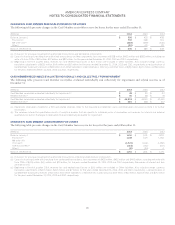American Express 2014 Annual Report Download - page 84
Download and view the complete annual report
Please find page 84 of the 2014 American Express annual report below. You can navigate through the pages in the report by either clicking on the pages listed below, or by using the keyword search tool below to find specific information within the annual report.
AMERICAN EXPRESS COMPANY
NOTES TO CONSOLIDATED FINANCIAL STATEMENTS
The following table provides information for the years ended December 31, 2014, 2013 and 2012, with respect to the USCS Card Member
loans and receivables modified as TDRs that subsequently defaulted within 12 months of modification. A Card Member is considered in
default from a modification program after one and up to two consecutive missed payments, depending on the terms of the modification
program. For all Card Members that defaulted from a modification program, the probability of default is factored into the reserves for Card
Member loans and receivables. The defaulted ICS Card Member loan and receivable modifications were not significant.
2014
(Accounts in thousands, Dollars in millions)
Number of
Accounts
Aggregated
Outstanding
Balances
Upon Default(a)
Troubled Debt Restructurings That Subsequently Defaulted:
Card Member Loans 10 $ 85
Card Member Receivables 344
Total 13 $ 129
2013
(Accounts in thousands, Dollars in millions)
Number of
Accounts
Aggregated
Outstanding
Balances
Upon Default(a)
Troubled Debt Restructurings That Subsequently Defaulted:
Card Member Loans 18 $ 159
Card Member Receivables 338
Total 21 $ 197
2012
(Accounts in thousands, Dollars in millions)
Number of
Accounts
Aggregated
Outstanding
Balances
Upon Default(a)
Troubled Debt Restructurings That Subsequently Defaulted:
Card Member Loans 23 $ 182
Card Member Receivables 137
Total 24 $ 219
(a) The outstanding balance includes principal, fees, and accrued interest on Card Member loans and principal and fees on Card Member receivables.
NOTE 4
RESERVES FOR LOSSES
Reserves for losses relating to Card Member loans and receivables represent management’s best estimate of the probable inherent losses in
the Company’s outstanding portfolio of loans and receivables, as of the Balance Sheet date. Management’s evaluation process requires certain
estimates and judgments.
Reserves for losses are primarily based upon statistical and analytical models that analyze portfolio performance and reflect management’s
judgment regarding the quantitative components of the reserve. The models take into account several factors, including delinquency based
loss migration rates, loss emergence periods and average losses and recoveries over an appropriate historical period. Management considers
whether to adjust the quantitative reserves for certain external and internal qualitative factors, which may increase or decrease the reserves
for losses on Card Member loans and receivables. External factors include employment, spend, sentiment, housing and credit, and changes in
the legal and regulatory environment while internal factors include increased risk in certain portfolios, impact of risk management initiatives,
changes in underwriting requirements and overall process stability. As part of this evaluation process, management also considers various
reserve coverage metrics, such as reserves as a percentage of past due amounts, reserves as a percentage of Card Member receivables or loans
and net write-off coverage ratios.
Card Member loans and receivables balances are written off when management considers amounts to be uncollectible, which is generally
determined by the number of days past due and is typically no later than 180 days past due. Card Member loans and receivables in
bankruptcy or owed by deceased individuals are generally written off upon notification, and recoveries are recognized as they are collected.
84
























